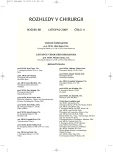Experimental Small Intestine Transplantation
Authors:
M. Oliverius; M. Kudla; P. Baláž; A. Valsamis; E. Honsová 1; A. Lodererová 1; J. Čáp 2; M. Adamec
Authors‘ workplace:
Klinika transplantační chirurgie IKEM, Praha
; IKEM, Praha
1; IKEM, Praha
2
Published in:
Rozhl. Chir., 2009, roč. 88, č. 11, s. 662-668.
Category:
Monothematic special - Original
Overview
Aim:
Transplantation of the small intestine is a standard treatment method in patients with small intestinal failures. The aim of this study was to master the surgical technique, optimalize immunosuppression regimes, diagnose acute cellular graft rejection based on cellular and humoral indicators.
Methods:
The authors performed a total of 43 transplantation procedures in pigs. The first, surgical part of the experiment was aimed at mastering two principal methods of vascular anastomosis– firstly, connecting the graft with mesenteric vessels (Group n1 = 18) and secondly, connecting the graft with the aorta and the inferior vena cava (Group n2 = 25). The second part of the experiment included assessment of rejection changes in various immunosuppression regimes. Only animals who did not die because of a technical failure of the procedure or due to internal reasons (n=24) were assessed. The study animals were assigned to four groups (A (n = 3) – autotransplantation, without immunosuppresion; B (n = 7) and C (n = 8) – allotransplantation with immunosuppression using tacrolimus, resp. in a combination with sirolimus; D (n = 6) – allotransplantation without immunosuppression.
Rejection was diagnosed based on histological examination of the grafts@ biopsy samples. Plasmatic citruline was used as a non- invasive humoral indicator of the graft impairment.
Results:
Procedural complications were observed in 12 (67%) study animals from the first group, and in 3 (12%) animals from the second group. In the assessment of rejection changes, the longest survival was observed with autotransplantations, the shortest survival period was shown with allotransplantations without immunosuppression. No significant survival differences were demonstrated between the both treated groups. (p < 0.05). Group C showed lower rates of cellular rejections, compared to Group B and D.
Conclusion:
During the experiment, the authors managed to master the graft collection, as well as the transplantation technique. Lower rates of surgical complications were observed when the graft was supplied by the central vascular system. No significant differencies were observed between the tacrolimus monoterapy regimen and the combination therapy with sirolimus. Histological examination is the golden standard for the cellular rejection diagnostics. Plasmatic citruline has no signifiance in the rejection assessment.
Key words:
small intestine transplantation– parenteral nutrition – acute cellular rejection – citruline – immunosuppression
Sources
1. Kocandrle, V., Houttuin, E., Prohaska, J. V. Regeneration of the lymphatics after autotransplantation and homotransplantation of the entire small intestine. Surgery, Gynecology & Obstetrics, 1966; 122(3): 587–592.
2. Balaz, P., Matia, I., Jackanin, S., Pomfy, M., Fronek, J., Ryska, M. Morphological changes of small bowel graft in Wistar rats after preservation injury. Bratislava Medical Journal, 2004; 105(2): 62–64.
3. Kudla, M., Kriz, J., Janotova, D., Girman, P., Mergental, H., Kocik, M., Honsova, E., Adamec, M. The effect of gemcitabine in the treatment of rejection in experimental small intestine transplantation. Folia Biologica., 2005; 51(3): 82–84.
4. Swine as Models in Biomedical Research. Ames, IA:Iowa State University 1992.
5. Oliverius, M., Balaz, P., Kudla, M., Valsamis, A., Cap, J., Adamec, M. Small bowel graft revascularization in experiment. Bratislava Medical Journal, 2009; 110(2): 65–68.
6. Caleja-Kempin, J., Estevez- Vazques, J., Cavanna, M. J., et al. Vascular trombosis in small bowel transplantation: a comparative study in pigs. Transplant. Proc., 1998; 30: 2646.
7. Alessiani, M., Spada, M., Vaccarisi, S., Ferrari, P., Zanola, S., Merli, M., Iacona, I., Noli, S., Dionigi, P., Zonta, A. Flexibility of the surgical model of intestinal transplantation in swine. Minerva Chir., 1997; 52(9): 1017–1028.
8. Alessiani, M., Ponti, F., Fayer, F., et al. The influence of surgery, immunosuppressive drugs, and rejection, on graft function after small bowel transplantation: a large-animal study. Transplant. Int., 2003; 16: 327–335.
9. Wu, T., Abu-Elmagd, K., Bond, G., Nalesnik, M. A., Randhawa, P., Demetris, J. A schema for histologic grading of small intestine allograft acute rejection. Transplantation, 2003; 8; 1241–1248.
10. Ruiz, P., Bagni, A., Brown, R., et al. Histological criteria for the identification of acute cellular rejection in human small bowel allografts: reselts of the patology workshop at the VIII International Small Bowel Transplantation Symposium. Transplant. Proc., 2004; 36: 335.
11. Oliverius, M., Král, D., Honsova, E., Lodererova A., Kudla, M., Balaz, P., Valsamis, A., Cap, J. Surgical technique of small bowel transplantation in a large animal model. Acta Veterinaria Brunensis, 2009; přijato do tisku
12. Oliverius, M., Kudla, M., Baláž, P., Valsamis, A., Adamec, M. Hladina plazmatického citrulinu – vhodný neinvazivního ukazatel poškození funkční masy enterocytů. Časopis lékařů českých, 2009; přijato do tisku
13. Nadalin, S., Biglarnia, A. R., Testa, G., et al. Role and signifikance of plasma citrulline in the early phase after small bowel transplantation in pigs. Transpl. Int., 2007; 20: 425–431.
14. Honsova, E., Lodererova, A., Balaz, P., Oliverius, M. Plasma citruline levels and acute cellular rejection early after small bowel transplantation in pigs. Veterinární Medicína, 2009; 54(5): 215–222.
Labels
Surgery Orthopaedics Trauma surgeryArticle was published in
Perspectives in Surgery

2009 Issue 11
- Metamizole vs. Tramadol in Postoperative Analgesia
- Metamizole at a Glance and in Practice – Effective Non-Opioid Analgesic for All Ages
- Possibilities of Using Metamizole in the Treatment of Acute Primary Headaches
Most read in this issue
- Case Report: Fat Embolism Syndrome – Grave Handicap after Traumatic Long-bones Fractures
- Traumatic Brain Injuries – Effects of Alcohol and Coffein on Intracranial Pressure and Cerebral Blood Flow
- Pacient s entrapment syndrómom a. poplitea a infekčnou endokarditídou (kazuistika)
- Cervical Disc Arthroplasty (Prodisc-C): Analysis of 3 to 4- Year Follow Up Results
